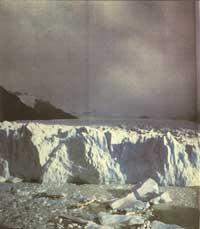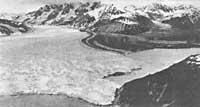Coastal glaciers
1988/08/01 Sagarna, Andoni - Ingeniaria Iturria: Elhuyar aldizkaria
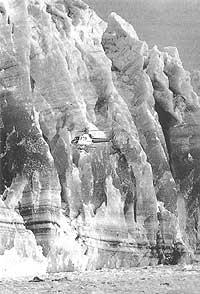
It moves like a conveyor belt due to the gravity of the ice and the snow accumulated in the rear called accumulation zone (1). At the bottom known as ablation zone (2), the glacier loses ice by melting and evaporating. Both zones are joined by one (3) balance line. If the balance is balanced (because the new snow equals the loss), the glacier will be stable and will not have great advances or delays. However, as the balance becomes unbalanced, it progresses or recedes.
In Alaska a few glaciers reach the sea. The advancing ice rocks and grinds the underlying rock, sandstones and gravel, preceded by a pile of earth and stones (4) called extreme moraine.
Sometimes a glacier (5) joins the main glacier to which it adds a strip of moraine (6). The extreme moraine hinders the advance of the glacier facade. There the ice melts, breaks and is divided into iceberg by sea blows.
Below the balance line is the cracked and slotted glacier (8). The water generated by melting the ice is poured through hidden channels and tunnels and when it reaches the bottom facilitates the pouring of the glacier acting as a lubricant. Finally comes loaded with mud below the end (9). As more snow or ice accumulates than the one that melts or evaporates in the glacier, it will advance, but if you push the extreme stone that holds into deeper water, the speed of advance will increase greatly.
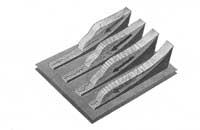
The glacier breaks quickly and the forehead stops in shallow waters. A new moraine is formed and the glacier resumes forward. Therefore, the fronts of the great coastal glaciers are always changing. They grow and decrease cyclically due to their internal dynamics, depending on the conditions they find in the valleys they cross and in the extreme zone. Prolonged weather events and permanent changes in precipitation regimes can also affect the behavior of these large rivers of ice.
The above-mentioned overcrowding is especially interesting. A glacier that normally travels slowly can reach a much higher speed for a short period of time. The speed increases between ten and a hundred times. Before this change (A) the glacier contains cracks and tunnels through which the water is poured. If this system is blocked for some reason, water pressure rises and slides some of the ice current. This section moves rapidly in slope (C). Like the chains of an excavator, the glacier is vibrated and dispersed. The phenomenon ends abruptly when the water finds the solution again. These scrubs occur in a few Alaska glaciers and often occur in a totally unpredictable way.
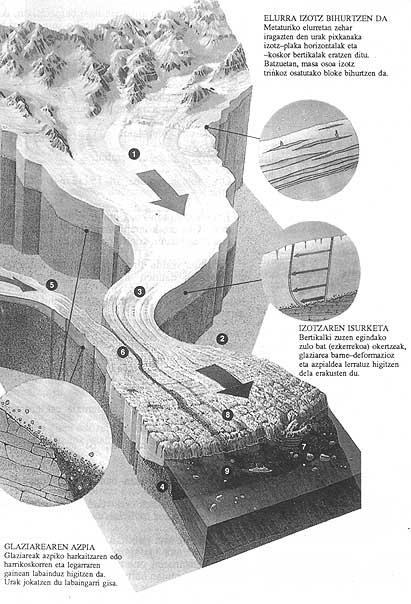

Gai honi buruzko eduki gehiago
Elhuyarrek garatutako teknologia




